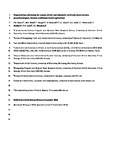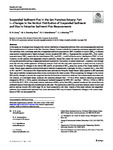Fingerprinting and tracing the sources of soils and sediments: Earth and ocean science, geoarchaeological, forensic, and human health applications
| dc.contributor.author | Owens, PN | |
| dc.contributor.author | Blake, William | |
| dc.contributor.author | Gaspar, L | |
| dc.contributor.author | Gateuille, D | |
| dc.contributor.author | Koiter, AJ | |
| dc.contributor.author | Lobb, DA | |
| dc.contributor.author | Petticrew, EL | |
| dc.contributor.author | Reiffarth, DG | |
| dc.contributor.author | Smith, HG | |
| dc.contributor.author | Woodward, JC | |
| dc.date.accessioned | 2017-01-05T09:56:44Z | |
| dc.date.available | 2017-01-05T09:56:44Z | |
| dc.date.issued | 2016-11 | |
| dc.identifier.issn | 0012-8252 | |
| dc.identifier.issn | 1872-6828 | |
| dc.identifier.other | C | |
| dc.identifier.uri | http://hdl.handle.net/10026.1/8194 | |
| dc.description | publisher: Elsevier articletitle: Fingerprinting and tracing the sources of soils and sediments: Earth and ocean science, geoarchaeological, forensic, and human health applications journaltitle: Earth-Science Reviews articlelink: http://dx.doi.org/10.1016/j.earscirev.2016.08.012 content_type: article copyright: © 2016 Elsevier B.V. All rights reserved. | |
| dc.description.abstract |
Fine-grained sediment is perhaps the most widespread and pervasive contaminant in aquatic systems reflecting its role in influencing the quality of the water (e.g., turbidity, vector of chemicals and other pollutants) and its detrimental effect on infrastructure (e.g., dams, turbines) and aquatic habitats (e.g., salmonid spawning grounds) through sedimentation. Determining the sources of fine-grained sediment thus represents an important requirement for watershed and coastal management, as well as for understanding the evolution of landscapes and ocean basins. Sediment source fingerprinting utilizes the diagnostic physical, chemical and biological properties (i.e., tracers) of source materials to enable samples of collected sediment to be apportioned to these sources. This review examines the development of the technique within the earth and ocean sciences, focusing mainly on agricultural landscapes. However, the development of new tracers, such as compound-specific stable isotopes, has allowed the technique to be applied in a growing number of environmental settings including forested (including wildfire-impacted forests), urban and estuarine/coastal settings. This review also describes other applications of the fingerprinting approach such as geoarchaeological (e.g., archaeological site formation), forensic (e.g., identifying the sources of soil/sediment particles in criminal investigations) and human health (e.g., identifying the sources of airborne particulate matter, PM2.5) applications. Identifying commonalities in methods and approaches between environments and disciplines should foster collaboration and the exchange of ideas. Furthermore, refinement of the sediment source fingerprinting technique requires that several methodological issues be addressed. These methodological issues range from the initial sampling design to the interpretation of the final apportionment results. This review also identifies and assesses these methodological concerns. | |
| dc.format.extent | 1-23 | |
| dc.language | en | |
| dc.language.iso | en | |
| dc.publisher | Elsevier BV | |
| dc.subject | Sediment sources | |
| dc.subject | Sediment fingerprinting | |
| dc.subject | Tracing | |
| dc.subject | Sediment properties | |
| dc.subject | Fine-grained sediment | |
| dc.subject | Sediment provenance | |
| dc.title | Fingerprinting and tracing the sources of soils and sediments: Earth and ocean science, geoarchaeological, forensic, and human health applications | |
| dc.type | journal-article | |
| dc.type | Review | |
| dc.type | Journal | |
| plymouth.author-url | https://www.webofscience.com/api/gateway?GWVersion=2&SrcApp=PARTNER_APP&SrcAuth=LinksAMR&KeyUT=WOS:000388776700001&DestLinkType=FullRecord&DestApp=ALL_WOS&UsrCustomerID=11bb513d99f797142bcfeffcc58ea008 | |
| plymouth.volume | 162 | |
| plymouth.publication-status | Published | |
| plymouth.journal | Earth-Science Reviews | |
| dc.identifier.doi | 10.1016/j.earscirev.2016.08.012 | |
| plymouth.organisational-group | /Plymouth | |
| plymouth.organisational-group | /Plymouth/Admin Group - REF | |
| plymouth.organisational-group | /Plymouth/Admin Group - REF/REF Admin Group - FoSE | |
| plymouth.organisational-group | /Plymouth/Faculty of Science and Engineering | |
| plymouth.organisational-group | /Plymouth/Faculty of Science and Engineering/School of Geography, Earth and Environmental Sciences | |
| plymouth.organisational-group | /Plymouth/REF 2021 Researchers by UoA | |
| plymouth.organisational-group | /Plymouth/REF 2021 Researchers by UoA/UoA14 Geography and Environmental Studies | |
| plymouth.organisational-group | /Plymouth/Research Groups | |
| plymouth.organisational-group | /Plymouth/Research Groups/Marine Institute | |
| plymouth.organisational-group | /Plymouth/Users by role | |
| plymouth.organisational-group | /Plymouth/Users by role/Academics | |
| plymouth.organisational-group | /Plymouth/Users by role/Researchers in ResearchFish submission | |
| dcterms.dateAccepted | 2016-08-26 | |
| dc.rights.embargodate | 2017-9-3 | |
| dc.identifier.eissn | 1872-6828 | |
| dc.rights.embargoperiod | No embargo | |
| rioxxterms.versionofrecord | 10.1016/j.earscirev.2016.08.012 | |
| rioxxterms.licenseref.uri | http://www.rioxx.net/licenses/all-rights-reserved | |
| rioxxterms.licenseref.startdate | 2016-11 | |
| rioxxterms.type | Journal Article/Review |



